ASTM D2460 Cesium 137 Determination Test in Water
The ASTM D2460 test method is a critical procedure for determining the concentration of Cesium-137 (Cs-137) in water samples. This radiometric analysis technique is essential for environmental monitoring, nuclear waste management, and emergency response scenarios. Cesium-137 is a byproduct of fission processes used primarily in nuclear power plants and other applications involving radioactive materials.
The test method aims to ensure that the levels of Cs-137 are within acceptable limits as set by regulatory bodies such as the International Atomic Energy Agency (IAEA), the Environmental Protection Agency (EPA), and others. This is particularly important in regions where nuclear activities or waste disposal pose a risk to public health and the environment.
The ASTM D2460 method involves several key steps, including sample collection, preparation, and analysis using a low-background gamma spectrometer. The process begins with careful selection of water samples that may be contaminated with Cs-137. Samples are typically collected from known sources or areas where radioactive contamination is suspected.
Once collected, the water samples undergo rigorous pretreatment to remove any interfering elements such as potassium (K) and lead (Pb), which can mimic Cs-137 signatures in gamma spectrometry. This involves filtering the sample through a specific type of filter designed for low-background detection.
The filtered sample is then placed into a suitable container for analysis, ensuring it remains free from contamination until testing begins. The container must be compatible with the gamma spectrometer used and should not introduce any additional radioactivity.
During the analysis, the gamma spectrometer measures the intensity of radiation emitted by Cs-137 in the sample. This involves calibrating the instrument using reference standards that contain known amounts of Cs-137. The calibration step is crucial to ensure accurate and reliable results. After calibration, the sample is placed into the spectrometer, where it undergoes a series of measurements over time.
The data collected from these measurements are then analyzed using specific software algorithms designed for radiometric analysis. These algorithms account for background radiation levels and any interferences that may affect the accuracy of the results. The final step in the process is generating a report detailing the concentration of Cs-137 found in the sample, along with any potential sources of contamination or risk.
The ASTM D2460 method has been widely accepted and implemented globally for its precision and reliability. It complies with international standards such as ISO 8599:2009 for gamma spectrometry techniques used in environmental monitoring. This ensures that the results obtained are comparable across different laboratories, enhancing the credibility of the findings.
The test method is particularly useful in scenarios where there is a need to monitor Cs-137 levels following nuclear accidents or during routine checks at facilities handling radioactive materials. It plays a crucial role in ensuring compliance with regulatory requirements and protecting public health and safety.
Quality and Reliability Assurance
The quality of the ASTM D2460 Cesium 137 Determination Test is paramount, given its importance in environmental monitoring and nuclear safety. To ensure reliable results, our laboratory employs stringent quality control measures throughout every stage of the testing process.
Our team adheres to ISO 9001:2015 standards for quality management systems, ensuring that all procedures are followed consistently and accurately. Regular audits by independent agencies verify compliance with these standards. Additionally, our personnel undergo continuous training in radiation safety protocols and analytical techniques to maintain proficiency.
Sample preparation is critical, and we use state-of-the-art equipment to ensure minimal contamination. Calibration of the gamma spectrometer is performed regularly using certified reference materials. This not only maintains instrument accuracy but also provides a traceable reference for our results.
Data analysis employs advanced software that automatically adjusts for background radiation and other interferences, ensuring precise measurements. Our reports include detailed information on methodology, calibration, and any potential sources of error or bias. This transparency enhances trust in the results produced by our laboratory.
International Acceptance and Recognition
- The ASTM D2460 Cesium-137 Determination Test is widely recognized internationally, with acceptance by regulatory bodies in numerous countries including the United States, Canada, Japan, and European Union member states.
- This test method aligns with ISO 8599:2009 standards for gamma spectrometry techniques used in environmental monitoring. Compliance with these international standards ensures that results are comparable across borders.
- The United Nations Scientific Committee on the Effects of Atomic Radiation (UNSCEAR) recommends the ASTM D2460 method as a reliable approach for Cs-137 detection in water samples.
- International Atomic Energy Agency (IAEA) guidelines also recommend this test method, emphasizing its role in nuclear safety and environmental protection.
Competitive Advantage and Market Impact
The ability to accurately determine Cs-137 levels in water samples provides significant competitive advantages for companies operating in the water treatment, nuclear waste management, and environmental monitoring sectors. Our laboratory offers this service with unmatched precision and reliability, ensuring that clients meet regulatory requirements and protect public health.
By using ASTM D2460, we can identify potential sources of contamination early on, allowing for proactive measures to mitigate risks. This capability is especially valuable in regions prone to nuclear incidents or where there are ongoing nuclear activities. Our services help companies stay ahead of regulatory changes and maintain a strong reputation for environmental stewardship.
In the context of nuclear waste management, accurate Cs-137 determination ensures that facilities can safely dispose of radioactive materials without posing risks to the environment or public safety. For water treatment plants, this service enables them to provide safe drinking water by detecting and removing any harmful levels of Cs-137.
The market impact of our services extends beyond individual clients. By providing reliable data on Cs-137 levels in environmental samples, we contribute to a safer and more sustainable world. This aligns with global initiatives aimed at reducing the risks associated with nuclear activities and protecting public health.





